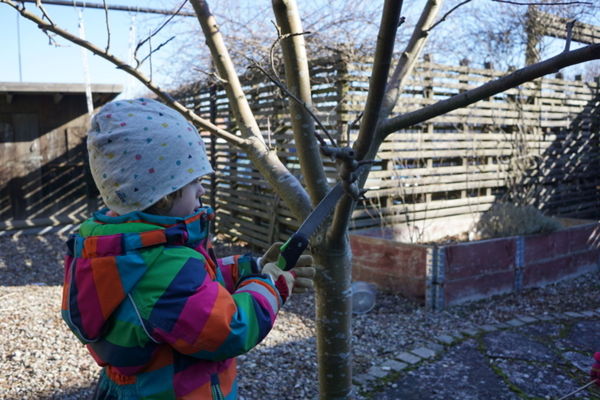Tend a fruit tree
Learn to plant and tend a young fruit tree: water, mulch, prune lightly, check for pests, and harvest small fruits while keeping it healthy.



Step-by-step guide to plant and tend a young fruit tree
Learn These 4 Methods to MASTER Pruning Fruit Trees
Step 1
Choose a sunny spot with good drainage where your tree will get at least 6 hours of sun.
Step 2
Put on your gardening gloves to protect your hands.
Step 3
Dig a hole about twice as wide as the root ball and the same depth as the pot.
Step 4
Gently take the sapling out of its pot without pulling on the trunk.
Step 5
Place the sapling in the hole so the top of the root ball is level with the soil surface.
Step 6
Fill the hole with soil and press it down gently to remove big air pockets.
Step 7
Water the newly planted tree slowly until the soil is evenly moist but not flooded.
Step 8
Spread a ring of mulch 2 to 3 inches thick around the base and leave a few inches of space away from the trunk.
Step 9
Write today's date and a watering plan in your notebook so you remember when to water.
Step 10
Every week check leaves and branches for pests spots or unusual changes.
Step 11
Write any problems or changes you see in your notebook so you can track them.
Step 12
Prune small dead or crossing branches carefully with kid-safe shears while an adult watches.
Step 13
Pick ripe fruit gently by twisting and placing each one into your basket.
Step 14
Count the fruit you harvested and write the number and how they tasted in your notebook.
Step 15
Share a photo and the story of your finished tree care project on DIY.org.
Final steps
You're almost there! Complete all the steps, bring your creation to life, post it, and conquer the challenge!


Help!?
If I can't find specific materials, what can I substitute for gardening gloves, mulch, or kid-safe shears?
Use sturdy household gloves or old work gloves instead of gardening gloves, shredded leaves or straw in place of bagged mulch, and have an adult use regular pruning shears while you hold branches or use blunt-tip safety scissors under supervision instead of kid-safe shears.
What should I do if the tree sinks in the hole or the soil stays soggy after planting?
If the tree sinks, lift and replant so the top of the root ball is level with the soil surface and press soil down to remove big air pockets, and if the soil remains soggy choose a sunnier spot with better drainage or water more slowly until the soil is evenly moist.
How can I adapt the steps of this activity for different age groups?
For toddlers let them wear gloves and help spread mulch or pour a small cup of water while an adult digs and records the planting date; for elementary kids let them dig the hole twice the root ball width, remove the sapling from its pot, press the soil, and write a watering plan in the notebook; for older kids and teens let them lead weekly pest checks, prune small dead branches with kid-safe shears while an adult watches, count and record harvests, and prepare the DIY.org story and photos.
How can we extend or personalize this tree-tending project once the basic steps are done?
Turn it into a longer project by keeping a dated growth chart and fruit-count log in your notebook, adding a painted stake with the planting date, installing a simple drip line or rain gauge to improve watering, mixing compost into the soil before backfilling, and taking weekly photos to compile the DIY.org story.
Watch videos on how to plant and tend a young fruit tree
Gardening for Kids! Fruit Tree Basics | Science for Homeschool and Public
Facts about fruit tree care for kids
✂️ Light pruning helps more sunlight reach branches and can lead to bigger, tastier fruit.
🌱 A 2–4 inch layer of mulch keeps soil moist, cool, and weed-free—it's like a cozy blanket for roots.
💧 A deep weekly soak encourages roots to grow strong—it's better than quick daily sprinkling for young trees.
🍎 Dwarf fruit trees can start producing fruit in just 2–4 years, so you might taste your first homegrown snack sooner than you think!
🐞 Ladybugs and lacewings are helpful garden friends that eat aphids and other tiny pests.
How do I teach my child to plant and tend a young fruit tree?
What materials and tools do I need to tend a young fruit tree with my child?
What ages is learning to plant and care for a fruit tree suitable for?
What are the benefits of involving my child in tending a fruit tree?


One subscription, many ways to play and learn.
Only $6.99 after trial. No credit card required


